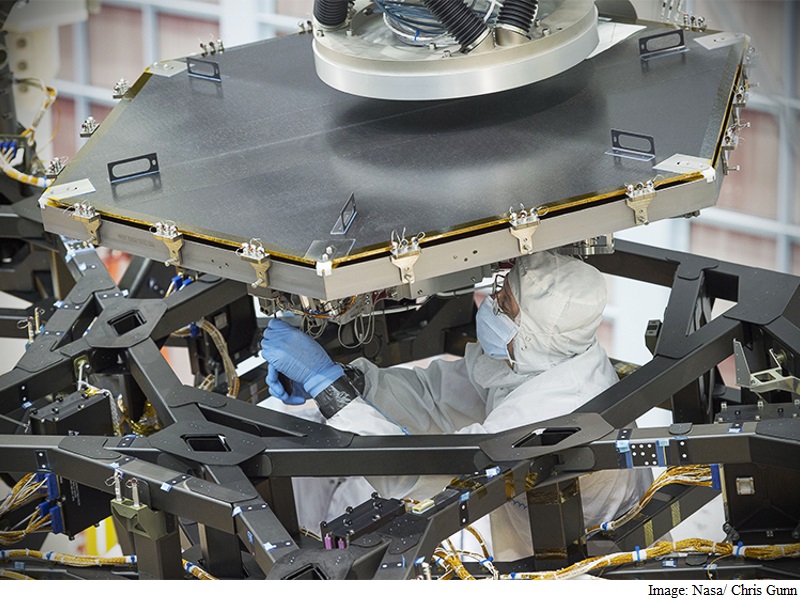- Home
- Science
- Science News
- Nasa Set to Replace Hubble With James Webb Space Telescope in 3 Years
Nasa Set to Replace Hubble With James Webb Space Telescope in 3 Years

After being pieced together, the 18 primary mirror segments will work together as one large 21.3-foot mirror.
The full installation is expected to be complete early next year.
"The James Webb Space Telescope will be the premier astronomical observatory of the next decade," said John Grunsfeld, astronaut and associate administrator of the Science Mission Directorate at Nasa headquarters in Washington, DC, in a statement.
This first-mirror installation milestone symbolises all the new and specialised technology that was developed to enable the observatory to study the first stars and galaxies, provide answers to the evolution of our own solar system and make the next big steps in the search for life beyond Earth on exoplanets.
Several innovative technologies have been developed for the Webb Telescope which is targeted for launch in 2018.
Webb will study every phase in the history of our universe, including the cosmos' first luminous glows, the formation of solar systems capable of supporting life on planets like Earth, and the evolution of our own solar system.
The 18 separate segments unfold and adjust to shape after launch.
The mirrors are made of ultra-lightweight beryllium chosen for its thermal and mechanical properties at cryogenic temperatures.
Each segment also has a thin gold coating chosen for its ability to reflect infrared light.
The telescope's biggest feature is a tennis court sized five-layer sunshield that attenuates heat from the sun more than a million times.
The mirrors must remain precisely aligned in space in order for Webb to successfully carry out science investigations.
While operating at extraordinarily cold temperatures, the backplane must not move more than 38 nanometers, approximately one thousandth the diameter of a human hair.
For the latest tech news and reviews, follow Gadgets 360 on X, Facebook, WhatsApp, Threads and Google News. For the latest videos on gadgets and tech, subscribe to our YouTube channel. If you want to know everything about top influencers, follow our in-house Who'sThat360 on Instagram and YouTube.
Related Stories
- AI
- iPhone 16 Leaks
- Apple Vision Pro
- Oneplus 12
- iPhone 14
- Apple iPhone 15
- OnePlus Nord CE 3 Lite 5G
- iPhone 13
- Xiaomi 14 Pro
- Oppo Find N3
- Tecno Spark Go (2023)
- Realme V30
- Best Phones Under 25000
- Samsung Galaxy S24 Series
- Cryptocurrency
- iQoo 12
- Samsung Galaxy S24 Ultra
- Giottus
- Samsung Galaxy Z Flip 5
- Apple 'Scary Fast'
- Housefull 5
- GoPro Hero 12 Black Review
- Invincible Season 2
- JioGlass
- HD Ready TV
- Laptop Under 50000
- Smartwatch Under 10000
- Latest Mobile Phones
- Compare Phones
- iQOO Z9x
- iQOO Z9
- HMD Pulse
- HMD Pulse+
- HMD Pulse Pro
- Realme Narzo 70x 5G
- Realme Narzo 70 5G
- Samsung Galaxy C55
- Lenovo IdeaPad Pro 5i
- Asus ZenBook Duo 2024 (UX8406)
- Realme Pad 2 Wi-Fi
- Redmi Pad Pro
- boAt Storm Call 3
- Lava ProWatch Zn
- Samsung Samsung Neo QLED 8K Smart TV QN800D
- Samsung Neo QLED 4K Smart TV (QN90D)
- Sony PlayStation 5 Slim Digital Edition
- Sony PlayStation 5 Slim
- Lloyd 1.5 Ton 3 Star Inverter Split AC (GLS18I3FOSEW)
- Haier 1.5 Ton 3 Star Triple Inverter Split AC (HSU18K-PYSS3BN-INV)

















